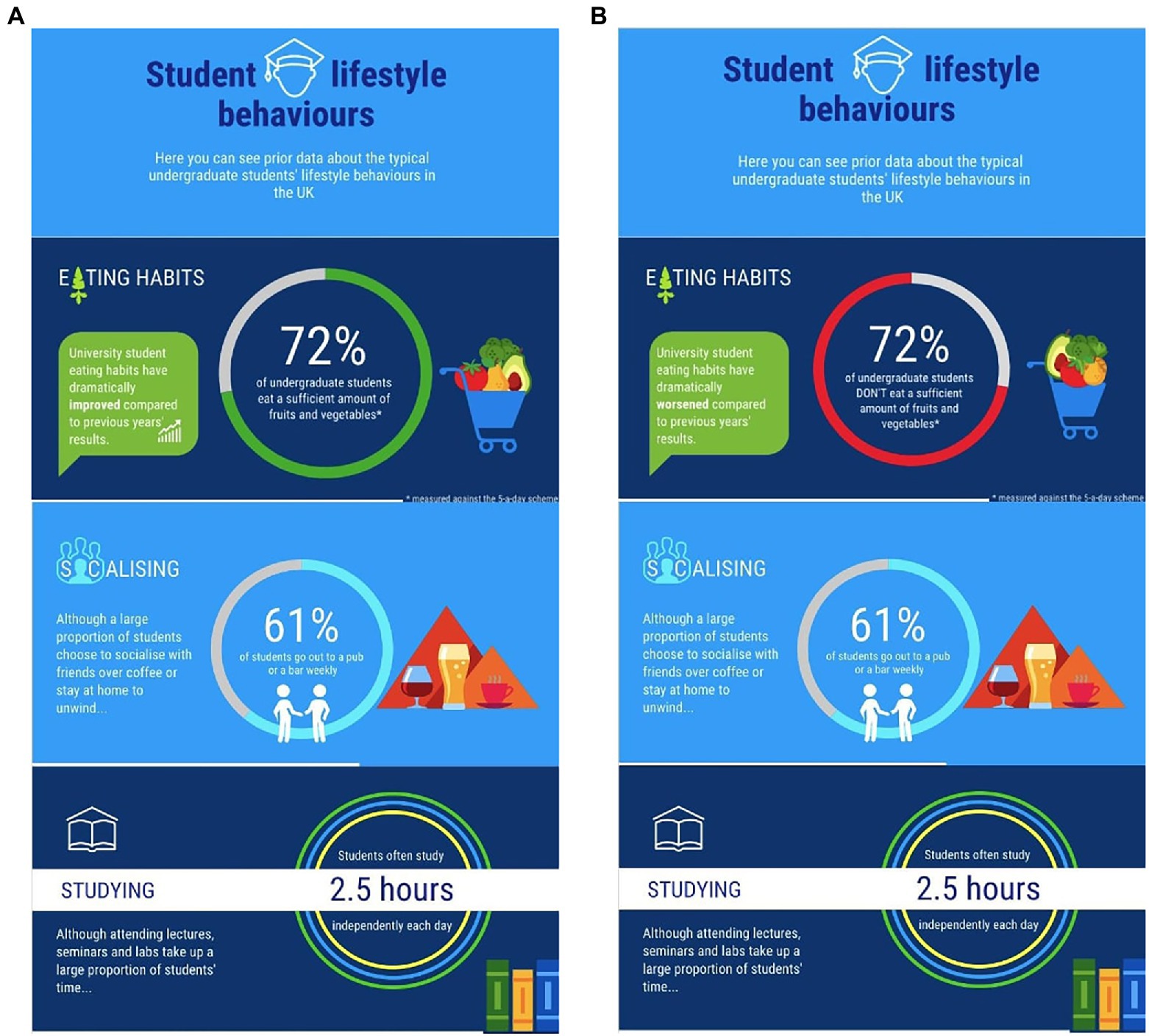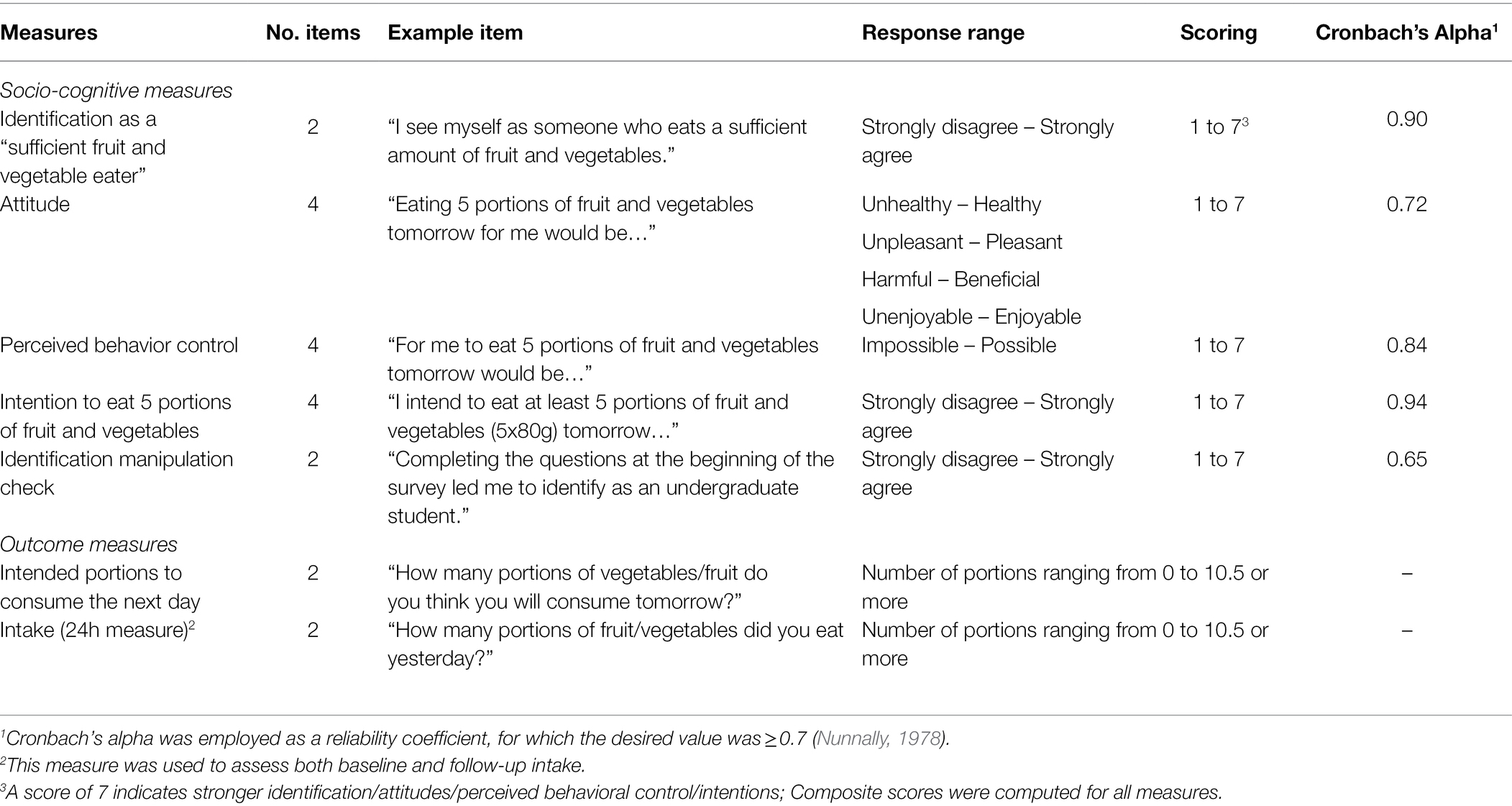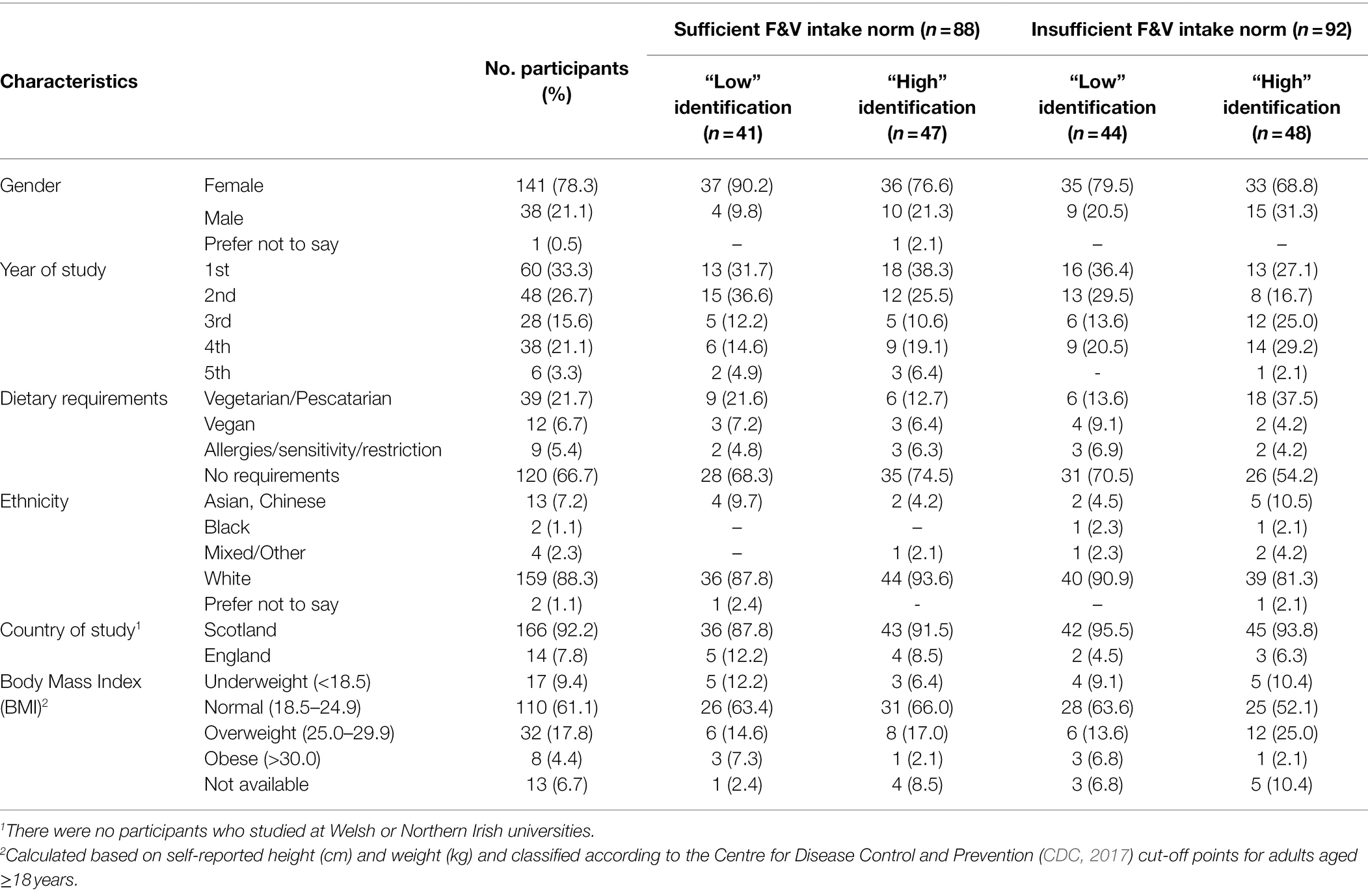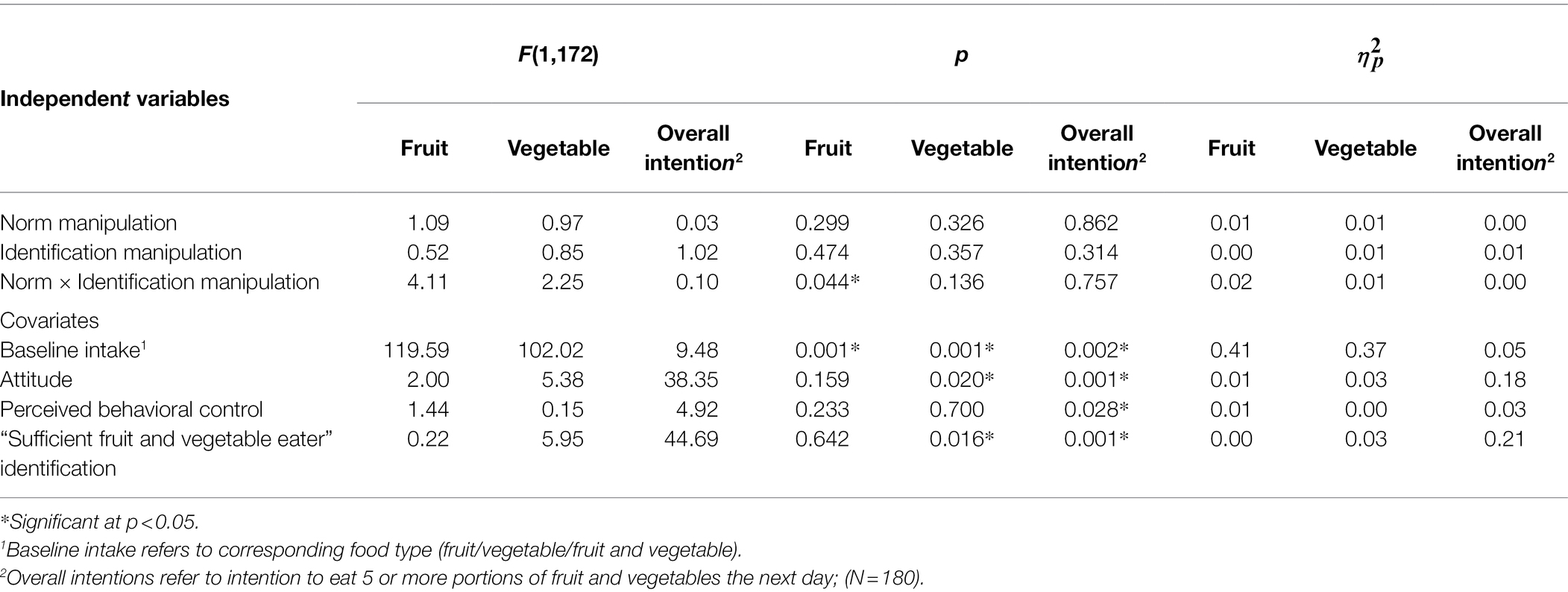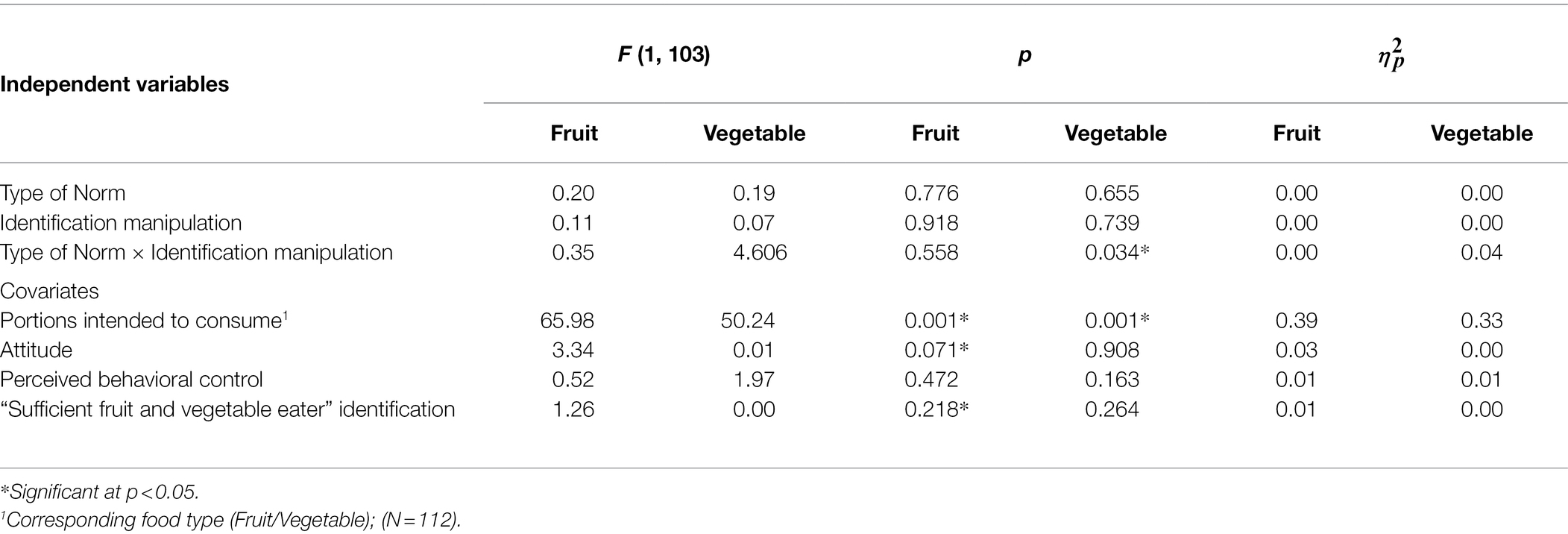- 1School of Medicine, North Haugh, University of St Andrews, St Andrews, United Kingdom
- 2School of Psychology, College of Life and Environmental Sciences, University of Birmingham, Birmingham, United Kingdom
This study investigated the influence of descriptive norm messages that either communicated that university students eat a sufficient amount of fruit and vegetable (F&V) or that they do not, on F&V consumption, and whether or not any effects are moderated by student identification. An online 2 (Norm: “Sufficient”/“Insufficient”) × 2 (Identification: “Low”/“High”) experimental design was employed. Infographics containing “sufficient”/“insufficient” F&V intake descriptive norms were presented. An identification manipulation was employed to create “high”/“low” student identifiers. F&V intake intentions were assessed after the manipulations; self-reported F&V intake was reported at 2 days post-intervention. Undergraduate students in the United Kingdom (N = 180) reported their intake intentions, of which 112 (62%) completed the behavioral follow-up. Participants were predominantly white female students from Scottish universities, mean age 20.4 (±1.6) years. Baseline mean F&V consumption was high (4.5 ± 2.8). There were no significant main effects of Norm or Identification manipulations on F&V intentions and intake. Significant norm × identification interactions were revealed for fruit intake intentions and vegetable intake at follow-up, indicating half-portion differences (~40 g) between groups. Ironic effects were observed for “high” identifiers, who neither intended to, nor acted in accordance with group norms; “low” student identifiers intended to and followed group norms, whereby the “sufficient”/“low” group intended to consume significantly more fruit portions and consumed more vegetables than the “insufficient”/“low” group. Given the half-portion differences between groups resulting from the norm × identification interactions, future research on a larger sample of young adults with low F&V intake is warranted to further explore the conditions under which moderating effects of identification are observed and the underlying mechanisms.
Introduction
A robust association exists between fruit and vegetable (F&V) consumption and reduction in all-cause mortality and in the occurrence of several chronic diseases such as cancer and cardiovascular disease (Wang et al., 2014; Aune et al., 2017). The United Kingdom (National Health Service (NHS), 2018) recommends that adults (≥18 years old) should consume at least five portions (5 × 80g) of F&V daily. Despite the introduction of the national “5-a-day” campaign (National Health Service, 2018), the latest surveys show national consumption of F&V falls short of the recommended amount (Rose, 2018; NHS Digital, 2019). The age cohort who consume the least F&V are young adults (16–24 years), who, in England, consume approximately 3.3 portions daily (NHS Digital, 2019), while intake by their Scottish counterparts is lower at 3.2 portions daily (Rose, 2018).
Young adults’ low F&V consumption is concerning as it is the period in which eating habits begin to form, after which resistance to change of established habits increases with age (Gall et al., 2000; Lien et al., 2001). Young adults’ eating behavior is predominantly influenced by peers (Stok et al., 2015; König et al., 2017). Therefore, harnessing social influences may be an effective approach to improving F&V intake (Higgs and Thomas, 2016; Stok et al., 2016).
Social norms are defined as behavioral standards that indicate appropriate and correct behavior (Aronson et al., 1998) and can be used in models as determinants of intentions and behavior. For example, the Theory of Planned Behavior (TPB; Ajzen, 1991) posits that intentions are determined by one’s attitudes, perceived behavioral control, and subjective norms (i.e., one’s norm perceptions) and predicts subsequent behavior from intentions (Ajzen and Madden, 1986). Norms may reflect what the group should be doing, i.e., perceived approval about a behavior (injunctive norms) or what the group is actually doing, i.e., perceived behavior (descriptive norms; Cialdini et al., 1990). Exposure to descriptive norm messages has been found consistently to alter eating behaviors in field experiments (Mollen et al., 2013; Thomas et al., 2017), experimental laboratory studies (Stok et al., 2012, 2014b), systematic reviews, and meta-analyses (Robinson et al., 2014b; Stok et al., 2016 for reviews). Recent research also indicates that descriptive norms are often more successful in increasing F&V intake than conventional messages highlighting the health implications of consuming sufficient F&V (Croker et al., 2009; Mollen et al., 2013; Robinson et al., 2014a).
Prior studies have used non-norm-based messages as a comparator to descriptive norm-based messages. However, de Bruijn et al. (2015) argue that such control messages lack validity. When it comes to “real-life” normative content, it is norms regarding unhealthy behavior—problem behavior—that are most frequently conveyed by mass media and health campaigns (Schultz et al., 2007; Stok et al., 2012; Niederdeppe et al., 2014). de Bruijn et al. (2015) have investigated whether desired descriptive norms were effective when compared with undesired or “problem” descriptive norms on eating intentions (fruit) and behavior, but this small study focused on older adults who may be less sensitive to normative influences than young adults (16–24 years old; Steinberg and Monahan, 2007). Therefore, the impact of descriptive norms highlighting desired behaviors (i.e., sufficient intake) compared with those that focus on problem behaviors (i.e., insufficient intake) on eating intentions and behavior is unclear.
When individuals identify with a group they are more motivated to adhere to in-group norms than out-group norms (Higgs, 2015; Reynolds et al., 2015; Tarrant et al., 2015). Young adulthood is the period throughout which individuals acquire a range of identities (e.g., student) and are motivated by their need to belong (Baumeister and Leary, 1995; Arnett, 2000). Within an eating behavior context, Louis et al. (2007) were the first to investigate the association between group identification strength and perceived eating norms in a longitudinal predictive study. They found high identifiers reported group-congruent intentions, whereas low identifiers did not. However, in a two-week follow-up, identification strength was not found to predict behavior (Louis et al., 2007). Further evidence suggests that the effect of identification strength on the influence of norms on eating behavior is not conclusive (Dempsey et al., 2018), with recent studies suggesting that high identification may result in both norm-divergent behavior (Banas et al., 2016) and convergent behavior (Liu et al., 2019).
The aim of this exploratory research was to investigate whether a descriptive norm message communicating a sufficient F&V intake norm is effective in improving F&V intake intentions and subsequent intake compared with a message communicating an insufficient F&V intake norm. Additionally, we explored whether the influence of the descriptive norm messages depends on the strength of student identification. To examine the effect of identity strength, an identity manipulation was included to categorize participants into distinct “low” and “high” identifier groups.
Materials and Methods
Participants and Recruitment
Eligible participants were undergraduate students in the United Kingdom aged 18 years or above, and were recruited via social media (e.g., Facebook and Twitter) between April and June 2019. Power analysis using G*Power determined a target sample size of 128 participants for ANCOVA that is powered for fixed effects, main effects, and interactions, with alpha set at 0.05 and power at 0.80 (Cohen, 1992) to detect a medium effect size (f = 0.25; Erdfelder et al., 2007). This estimate is consistent with previous research demonstrating that studies investigating the effects of eating norms usually detect a small to medium effect size (Robinson et al., 2014b; de Bruijn et al., 2015). Ethical approval was granted by the University Teaching and Research Ethics Committee at the University of St Andrews (MD14242).
Design
The study employed a randomized, 2×2 between-subjects, pretest/posttest design. The two independent variables were “Descriptive Norm” messages (“sufficient”/“insufficient” F&V intake norm) and “Identification Strength” (“low”/“high”). The study was completed online via Qualtrics which, after providing consent, automatically randomized participants in a 1:1 ratio to four groups. The dependent variables were: (a) F&V intake intentions following the norm-based message (see “Part 1”) and (b) self-reported F&V intake at two-day follow-up (see “Part 2”).
Materials
Identification Manipulation
The study involved a between-subjects identification manipulation to expose participants to statements loaded about positive and negative characteristics of student identity (Table 1). Two types of identification manipulations occurred following Greenaway et al.’s (2015) example to create “high” and “low” identifiers. Participants in the “High Identification” group received five moderately positive and five extremely negative student identity-related statements; the “Low Identification” group was presented with five moderately negative and five extremely positive statements (Table 1). Greenaway et al.’s (2015) manipulation posits that the manipulation prompts participants to agree with moderate statements and disagree with the extreme ones. This manipulation has been successfully used by Banas et al. (2016) to create “low” and “high” identifiers in their social norms study. In line with the original manipulation, to ensure participants were aware of the number and valence of selected statements, they were asked to count both the number of negative and positive statements they agreed with. The actual act of counting of the statements participants agree with is the identity primer itself, and the scores were used to indicate identity strength in the analysis. Following this, participants were presented with the norm manipulation (described below).
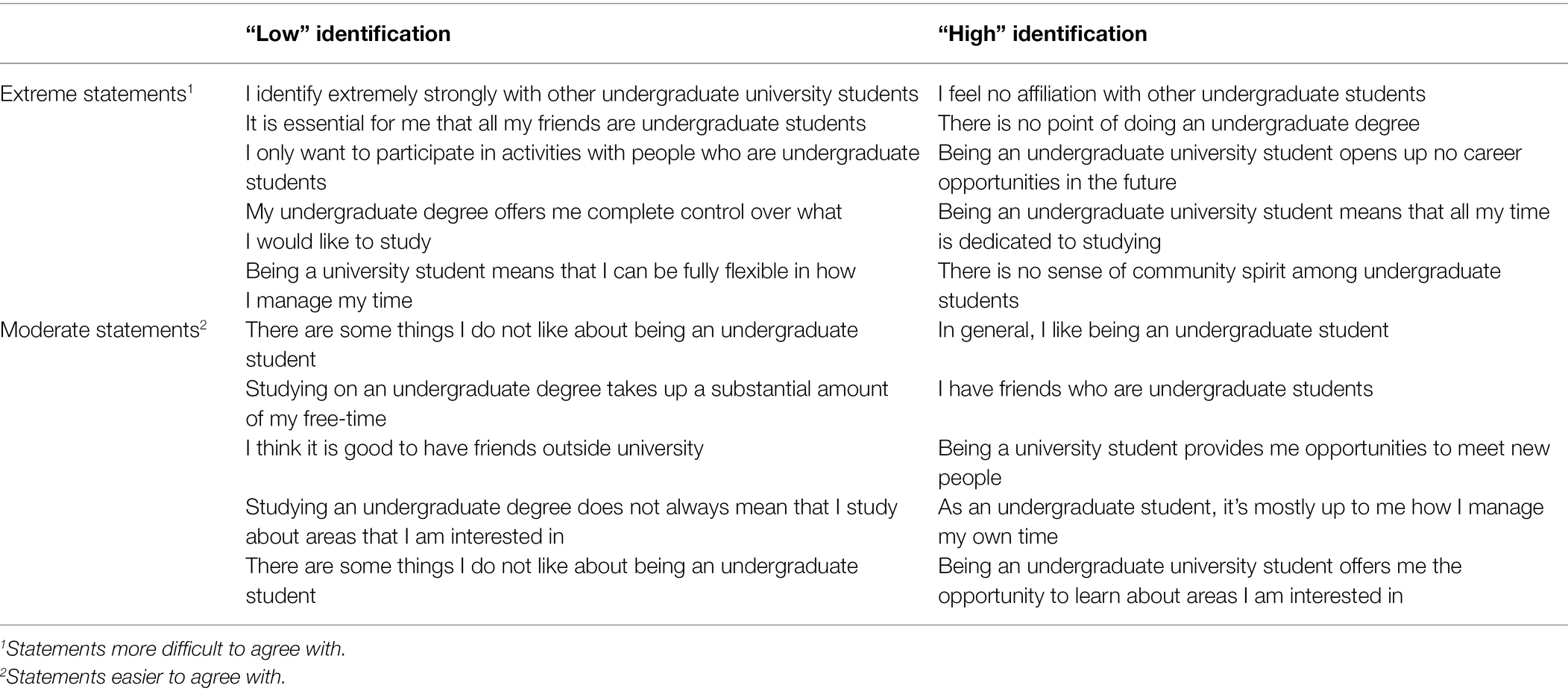
Table 1. Identification manipulation items created following the example of Greenaway et al. (2015).
Norm Manipulation
Following the identification manipulation, participants were asked to rate the clarity of an infographic (Figure 1). Participants were shown one infographic which displayed either a “sufficient” or “insufficient” F&V intake norm alongside additional, unrelated norms (e.g., studying habits) based on a fictitious lifestyle study. Participants were asked to retain the presented information as there was a test afterward, which served as an attention check for their recall of norms.
Attention Check
Following the presentation the infographic, participants were asked to recall the percentage of students who eat a “sufficient”/“insufficient” amount of F&V. Answers were accepted to deviate ±10% from the norm presented to them (Banas et al., 2016).
Socio-Cognitive Constructs
Attitudes, perceived behavioral control, and intentions to consume sufficient F&V were assessed by items adapted from Ajzen’s (2002) recommendations for creating a scale to measure these constructs in line with previous studies (e.g., Stok et al., 2014b; Table 2). Self-reported F&V intake was assessed by items adapted from Robinson et al. (2014b), which provide an accurate dietary recall over 24 h (Armstrong et al., 2000; Table 2). Guidance on how to determine portion sizes (~80 g) was provided for each question by an image taken from the Scottish Health Survey (Rose, 2018). Fruit and vegetable intake was self-reported separately.
Procedure
Part 1
Participants were invited to complete a 15-min “Lifestyle study” on United Kingdom undergraduate student behaviors. Consenting, eligible participants reported their baseline F&V intake, self-identification as a “sufficient F&V eater,” and socio-cognitive constructs (e.g., attitudes). As the true aim of the study was concealed from participants in an attempt to prevent social desirability bias (Miller et al., 2008), several filler questions were included (e.g., socializing habits), which were not analyzed. Following this, participants received the identification, and then the norm manipulations during the online survey. Demographics [age (year), gender, ethnicity, height (cm), weight (kg), student status (year and country), and dietary requirements] were collected to describe the sample. To match participant responses with the follow-up (see “Part 2” below), participants were guided to create a unique code (see Grube et al., 1989) and provided email addresses.
Part 2
Two days after Part 1, upon receipt of the automatic email invitation, participants were asked to self-report the number of F&V portions they consumed the previous day via the same 24 h fruit and vegetable online Qualtrics intake form that they answered in Part 1. Participants had the opportunity to enter a prize draw [Amazon voucher (4×£25)]. Upon submission of their answers, a participant debrief form detailed the true aim of the study.
Data Analyses
The research questions and the data analysis plan were pre-specified before the data were collected. Differences between the four manipulated groups in baseline F&V intake, demographics, and socio-cognitive constructs were assessed by one-way ANOVAs with group membership as a fixed factor. Manipulation and attention checks were assessed by two-way ANOVAs. Two-by-two ANCOVAs assessed the interaction and main effects of norms and identification manipulations on F&V consumption intentions and behavior (Rausch et al., 2003). Based on previous studies (Robinson et al., 2014a; Stok et al., 2014a), it was decided a priori to include attitudes, perceived behavioral control, self-identification as a “sufficient F&V eater,” and baseline intake or intentions as covariates to reduce within-group error variance (Field, 2009). Significant interactions were followed up with Bonferroni-adjusted simple main effects comparisons (Price et al., 2017); significance was determined at p < 0.05. Data were analyzed by SPSS v24.
Results
Descriptive Statistics
A total of 180 participants completed Part 1 (MAge = 20.36 ± 1.64), of which 112 (62.2%) were followed up in Part 2 (Figure 2). Participants not eligible (n = 28; e.g., <18–25 > years old, not a student), and those who left the study before (n = 117) and after (n = 20) being presented with the infographic, were excluded. Sample participants displayed positive attitudes and perceived behavioral control toward consuming 5 portions of F&V a day, as shown by scores above each scale’s mid-point (Table 3). The sample indicated a relatively high baseline F&V consumption, with a mean of 4.50 (SD = 2.86) F&V portions, of which 2.5 (SD = 2.02) and 1.98 (SD = 1.55) mean portions were fruit and vegetables, respectively.
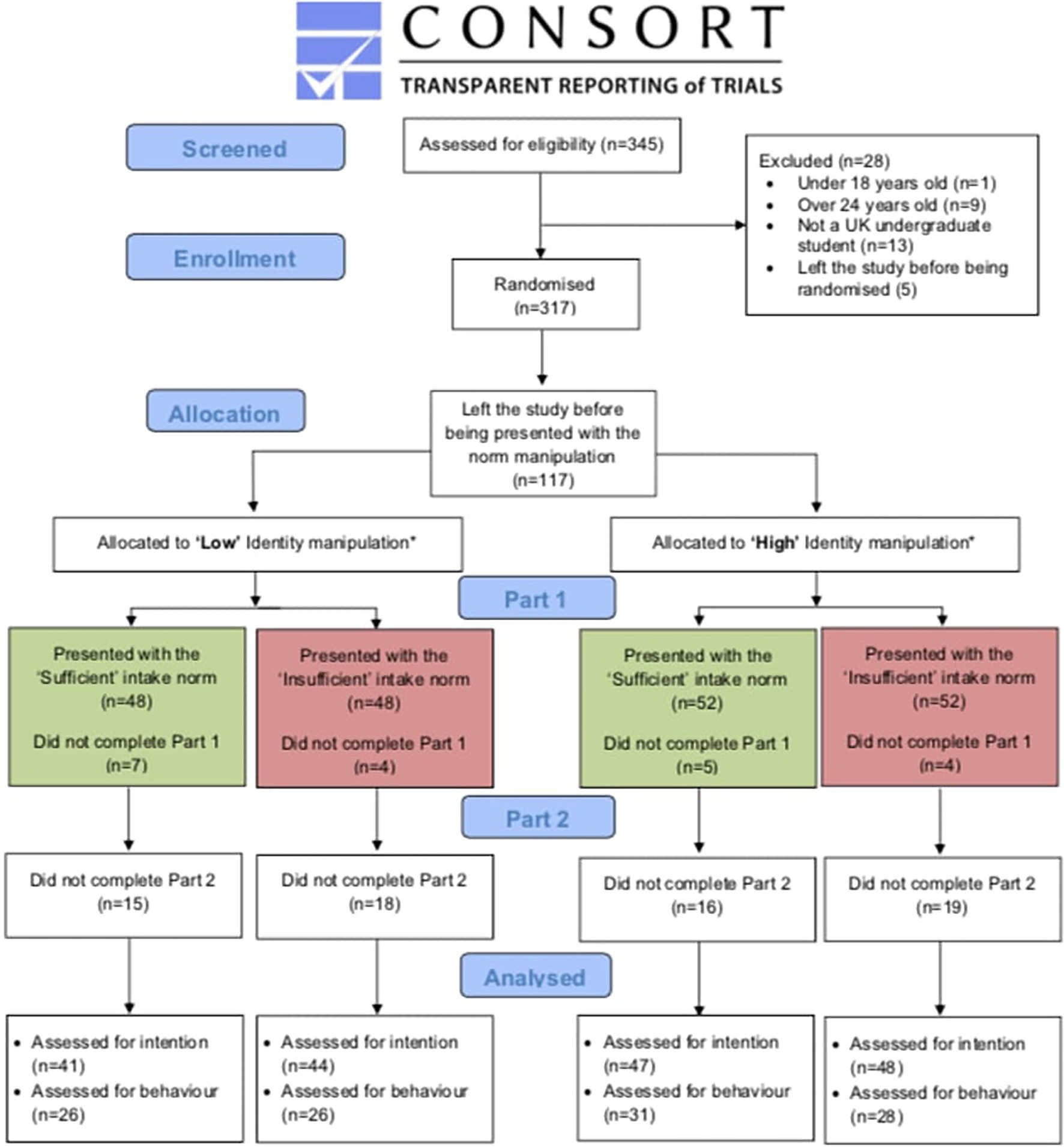
Figure 2. Participant recruitment, allocation, and retention (CONSORT; Schultz et al., 2007). Asterisk indicates that out of the 317 individuals who were allocated to the “low” or “high” identification manipulation, 117 left the study before being presented with the infographics conveying the manipulated norms.

Table 3. Means (and standard deviations) of baseline socio-cognitive measures and fruit and vegetable intake.
Groups did not differ in socio-cognitive constructs, baseline F&V intake, or demographic characteristics (Tables 3, 4; p > 0.115). Additionally, the proportionate attrition (Figure 2) was unrelated to condition, demographics, baseline F&V intake, and socio-cognitive constructs (p > 0.112). Participants were predominantly White female students from Scottish universities who were normal weight (61%; Table 4; CDC, 2017).
Identification Manipulation Check
ANOVA revealed a non-significant difference between the “low” (4.73 ± 1.34) and “high” (5.07 ± 1.34) identification conditions, F(1,179) = 2.97, p = 0.086, indicating the manipulation was not fully successful.
Attention Check
A total of 76.1% of participants recalled the descriptive norms displayed by the infographics correctly. Participants rated the infographics as easy to understand and well-presented. There was a significant difference in descriptive norm recall between conditions, with a larger percentage of correct recalls in the “insufficient” (84%) than the “sufficient” condition (68%), F(1,178) = 6.09, p = 0.015, = 0.03.
Intentions
Intention to Eat >5 F&V Portions (Part 1)
ANCOVA revealed no main effects of norms or identification on fruit intake intentions. The norm by identification manipulation interaction was significant, which generated a small effect size (Table 5). Simple main effects analysis revealed that when presented with “insufficient” norms, participants in the “high” identification group reported intentions to eat approximately half a portion more fruit (Mean differenceadjusted = 0.44, p = 0.05) than participants in the “low” identification manipulation group (Figure 3). Additionally, “low” identifiers in the “insufficient” condition intended to consume significantly fewer portions (Mean differenceadjusted = −0.49, p = 0.036) than participants in the “sufficient” condition (Figure 3). No main effects (norm or identification) nor interactions were found for vegetable intake intentions (Table 5). No main effects nor interactions were found for “overall intentions” to consume ≥5 F&V portions the next day (Table 5).
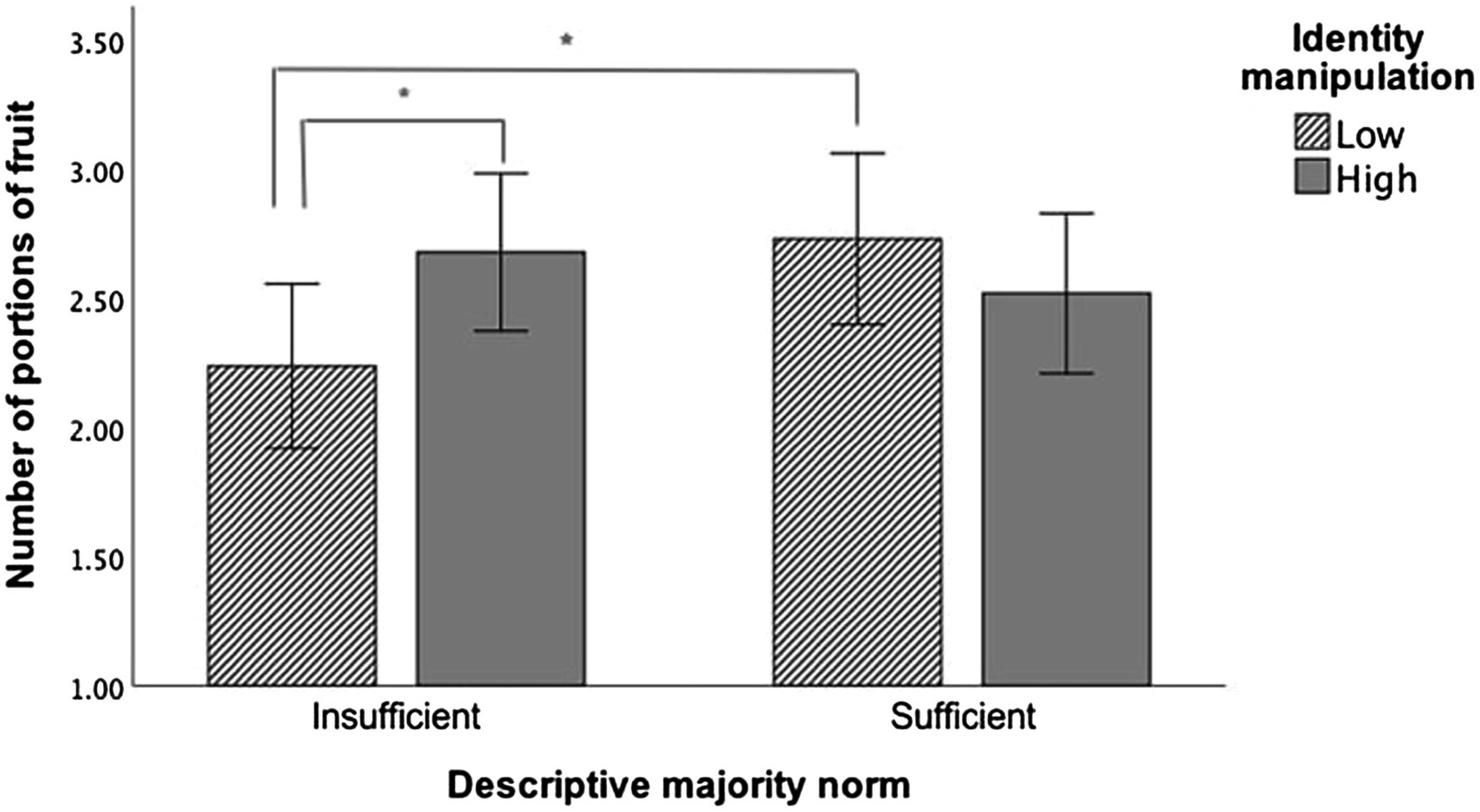
Figure 3. Bar graph illustrating the cross-over interaction of the Norm (“sufficient”/“insufficient”) and Identification (“low”/“high”) manipulations on the number of portions of fruit participants intended to consume the following day. The means are adjusted for baseline intake, attitudes, perceived behavioral control, and identification as a “sufficient fruit and vegetable eater.” Error bars display 95% confidence intervals. Asterisk indicates significant difference at *p < 0.05. (N = 180).
Intake: Number of F&V Portions Consumed (Part 2)
Participants self-reported their F&V intake in the two-day follow-up (Table 6). No main effects (norm and identification) nor interactions were found for self-reported fruit intake two days post-intervention (Table 7). No significant main effects were revealed for norm nor identification on vegetable intake (Table 7). The norm by identification manipulation interaction was significant (p = 0.034), which generated a small to medium effect size (Table 7; Figure 4). Although it was not significant, simple main effects analysis revealed that upon receiving the “insufficient” intake norm, participants in the “high” identification consumed approximately half a portion more vegetables (Mean differenceadjusted = 0.55, p = 0.095) than participants in the “low” condition. Participants under the “high” identification manipulation who received the “sufficient” intake norm consumed fewer portions (Mean differenceadjusted = −0.44, p = 0.179) than participants receiving the “low” identity manipulation. Additionally, a non-significant, half-portion difference (Mean differenceadjusted = 0.60; p = 0.079) was detected between the two “low” identifier groups, with those in the “sufficient” norm condition consuming more vegetables.

Table 6. Means (and Standard Deviations) for fruit and vegetable intake at two-day follow-up (Part 2).
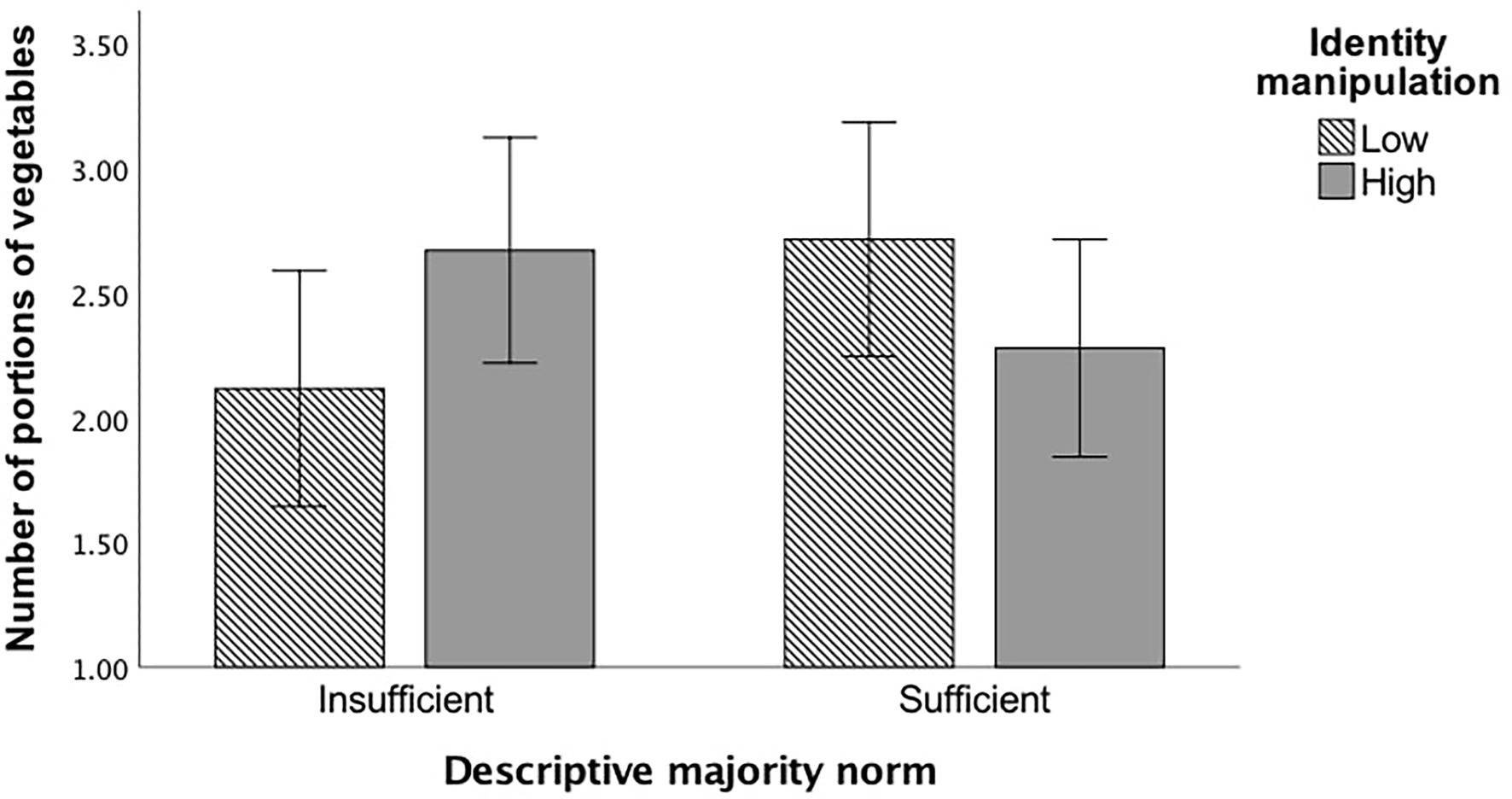
Figure 4. Bar graph illustrating the cross-over interaction of the Norm (“sufficient”/“insufficient”) and Identification (“low”/“high”) manipulations on the number of vegetable portions participants consumed at follow-up. The means are adjusted for attitudes, perceived behavioral control, intentions, and identification as a “sufficient fruit and vegetable eater” as covariates. Error bars represent 95% confidence intervals. (N = 111).
Discussion
This study compared the effect of a descriptive norm message communicating the “sufficient” F&V intake of in-group members with an “insufficient” F&V intake message, on immediate F&V intake intentions and subsequent intake at a two-day follow-up. Whether the impact of descriptive norms was dependent on student identification strength was also investigated by employing a manipulation to categorize students as “low”/“high” identifiers. The manipulation was not fully successful in creating distinct “low”/“high” identifiers, and participants in the “low” identification group displayed relatively high identification, which is frequently observed in studies (Stok et al., 2012; Banas et al., 2016; Liu and Higgs, 2019). We found that participants in the “low” identification group intended to and acted norm-congruently, while participants in the “high” identification group intended to and acted against the presented norms.
Some social norms research asserts that higher identification predicts norm-congruent behavior (Louis et al., 2007; Stok et al., 2012, 2014a). For example, in a similar study, Liu et al. (2019) investigated the relationship between descriptive norms and identification strength on participants’ F&V intake. The researchers primed one group’s student identity and showed participants a flyer or a poster either communicating descriptive norms about most students consuming over 5 portions of F&V daily or a health message conveying the benefits of eating 5-a-day. They found the primed group consumed 40 g more F&V from a buffet than the non-primed group. In contrast, the present data show that only the “low” identification group participants’ fruit intake intentions and vegetable intake were norm-congruent. Several explanations may be attributable to the differences in the current findings and Liu et al.’s (2019) experiment. Crucially, Liu et al.’s (2019) sample consumed 2 F&V portions at baseline, whereas our sample reported 4.5 portions. Previous studies have indicated substantial differences in the effect of norms on “high” and “low” F&V consumers, with “low” consumers being more prone to match norms (Schultz et al., 2007; Robinson and Higgs, 2012; Robinson et al., 2014a; Verkooijen et al., 2015). Therefore, the contrasting findings could be attributed to baseline F&V intake. Additionally, the difference between the identity manipulations used by Liu et al. (2019) and in the present study may also account for the observed contradictory results.
The present data also suggest that participants in the “high” identification group actually diverged from norms. This manifested in the present study in two ways. Firstly, participants in the “high” identification group intended to eat more fruit and increased their vegetable intake upon receiving the “insufficient” descriptive norm, although this was not significant. This may be explained by their desire not to be associated with a group which has unfavorable norms (Berger and Heath, 2007; Berger and Rand, 2008), leading to a compensatory behavior. Secondly, participants in the “high” identification group intended to eat fewer fruit portions and (non-significantly) decreased their vegetable intake by half a portion upon receiving the “sufficient” descriptive norm. The finding corroborates Banas et al. (2016), who demonstrated that “high” identifiers chose calorific food items from an online menu when presented with “healthy” descriptive norms, indicating the presence of ironic effects. Banas et al. (2016) suggested that observed ironic effects could be explained by vicarious licensing. Vicarious licensing posits when high identifiers perceive their in-group members making progress in achieving a goal (e.g., eating healthily), they may give an individual license to themselves (e.g., choose unhealthy food; Kouchaki, 2011). This ironic effect has primarily been associated with hedonic consumption, where one is offered an alternative choice (Wilcox et al., 2009; De Witt Huberts et al., 2012). However, as the current study did not investigate vicarious licensing, nor offer an alternative choice, a definitive conclusion cannot be drawn as to whether this is the underlying mechanism for the findings. Taken together, the data suggest that understanding of the moderating effects of identification on responses to eating norms requires further investigation.
In the present study, an approximate half-portion (~ 40 g) difference (non-significant) was consistently observed between descriptive norm conditions, which is noteworthy, given that long-term school-based dietary interventions for children (5–12 years) can only demonstrate an increase in F&V intake by an average of one-quarter to one-third of a portion (~20–30 g; Evans et al., 2012). The half-portion difference is clinically relevant given the dose-related relationship between F&V intake and diseases such as cardiovascular disease and cancer (Aune et al., 2017), and evidence indicating that each additional serving of fruit or vegetable a day is associated with 5–6% reduced risk of all-cause mortality (Wang et al., 2014).
It is important to note that as the manipulation was not fully successful to create distinct “low”/“high” identifiers, participants in the “low” identification group displayed relatively high identification, which is frequently observed in studies (Stok et al., 2012; Banas et al., 2016; Liu and Higgs, 2019). Consequently, the two identification groups could be regarded as “identifiers” and “extreme identifiers,” whereby “identifiers” perceive descriptive norms relevant, and thus act norm-congruently, a well-documented finding (Cruwys et al., 2012; Stok et al., 2012; Reynolds et al., 2015). Our findings showed that the intention and consumption of “identifiers” were poorer in the “insufficient” condition, which may be attributed to the “backlash” effect (Cialdini, 2003), which is an undesired behavioral outcome following exposure to undesired norms conveying problem behaviors about one’s in-group.
Our findings in relation to the “sufficient”/“desired” descriptive majority norms compared with “problem”/“insufficient” norms on intention and behavior show that when identity is not taken into account, there were no differences in their impact. These findings support the only similar investigation conducted to date by de Bruijn et al. (2015), who found desired descriptive norms had no effect on fruit intake intentions and intake when compared with undesired, “problem norm” content. These findings are broadly consistent with available field research on drinking behavior (Foxcroft et al., 2015). However, an explanation for the non-significant differences between descriptive norms may also lie in participants’ norm recall rates. Participants in the “insufficient” condition recalled norms more successfully than those in the “sufficient” condition, suggesting the bogus “sufficient” norm was perhaps perceived as inaccurate. In support of this suggestion, research shows students are generally perceived to be “unhealthy” (Tarrant and Butler, 2011) with students often overestimating peer’s poor health behaviors (Neighbors et al., 2006).
Strengths
A strength of this investigation is the norm-conveying infographics—regarded as well presented and clear by participants—which were designed to resemble content encountered in daily life. Therefore, the infographics are ecologically valid and can be employed in future research. Furthermore, the concealment of true study objectives during recruitment and the absence of the experimenter throughout data collection lessened the likelihood of social desirability bias, a bias commonly experienced in eating behavior research (Steim and Nemeroff, 1995; Nix and Wengreen, 2017). Overall, the investigation contributes to the limited experimental social norm studies exploring healthy eating and employing a follow-up self-reported intake measure, as opposed to immediate food choice measures or intention only (Robinson, 2015; Stok et al., 2018).
Limitations and Recommendations for Future Research
A limitation of this study relates to the identification manipulation which was not fully successful in creating distinct “low”/“high” identifiers, thereby limiting variability to detect a moderating role for identification on descriptive norm messages. Future research should aim to improve the manipulation to verify the direction of the interaction of descriptive norms and identification strength. Additionally, the analysis of intake was underpowered due to attrition and is acknowledged as a limitation. Furthermore, the norms were fictitious and norm recall rates were significantly different between the norm conditions. It is possible that the insufficient F&V intake norm manipulation seemed more credible compared to the sufficient norm manipulation to the participants. Future studies may test pre-existing norm perceptions and/or assess whether the norms are regarded as credible. An unexpected finding was the discrepancy observed between F&V intake intentions and behavior. Although measuring intentions is appropriate in predicting behavior (Kellar and Abraham, 2005; Ickes and Sharma, 2011), intentions do not necessarily manifest (Lien et al., 2001; Sniehotta et al., 2005) resulting in an intention-behavior gap.
The “lifestyle study” ostensibly attracted health-motivated participants, potentially leading to selection bias. This may explain why participants identified as “sufficient F&V eaters” and displayed relatively strong attitudes, perceived behavioral control, and intentions to eat 5-a-day. Additionally, the sample’s BMI distribution (61% healthy BMI) is not representative of adults in Scotland, as recent evidence indicates that prevalence of overweight (including obesity) is 65% for this cohort (Bardsley, 2018). Furthermore, asking participants to self-report their sufficient F&V eater identity may have had a priming effect that impacted the results.
As participants’ self-reported baseline consumption was at 4.5 F&V portions, which conforms approximately to the 5-a-day norm presented, it is plausible that a ceiling effect was observed. The sample’s baseline consumption is substantially higher than intake levels reported in national surveys of young adults’, and cross-sectional investigations of undergraduate students’ eating practices (Tanton et al., 2015; Rose, 2018; Sprake et al., 2018). This may be due to the high proportion of vegetarian/vegan participants at 28.4% in the sample, who typically eat more F&V than meat-eaters (Walsh et al., 2017). Overall, the external validity of the sample is thus limited, which is furthered by the predominant participation of white, female students studying in Scotland. Future research obtaining larger and demographically diverse samples displaying the nationally observed low F&V consumption is warranted.
Practical Implications
The finding that participants in the “low” identification group intended to and consumed fewer portions when presented with “insufficient” descriptive norms tentatively suggests that this kind of normative content may instigate unwanted outcomes (i.e., “backlash effect”), and therefore, conveying descriptive norms about problem behaviors in health promotion material should be cautioned. Additionally, the present findings add to the disagreement in the literature regarding the direction of the norm×identification interaction due to potential ironic effects for participants in the “high” identification group’ intentions and behavior. Hence, these findings warrant further investigations of the underlying mechanisms, such as vicarious licensing, to offer a solution for harnessing the benefits of in-group identification in health promotion.
Conclusion
Although descriptive norms offer a cost-effective and simple approach to improve F&V intake intentions and behavior, and are successful when compared with no-norm controls and health messages (Robinson et al., 2014a), their effectiveness has not yet been demonstrated compared with undesired normative content in an eating behavior context. However, descriptive norms influenced fruit intake intentions and vegetable intake when investigated for their interaction with the identification manipulation, with participants in the “low” identification group acting norm-congruently, and participants in the “high” identification group diverging from the presented norms. The latter potentially suggests the ironic effects of high identification on behavior. Whether the findings generalize to other health behavior contexts, and to the general young adult population who would benefit from F&V intake improvement, remains subject to further investigation.
Data Availability Statement
The raw data supporting the conclusions of this article will be made available by the authors, without undue reservation.
Ethics Statement
The studies involving human participants were reviewed and approved by the University Teaching and Research Ethics Committee at the University of St Andrews (MD14242). The participants provided their written informed consent to participate in this study.
Author Contributions
All authors listed have made a substantial, direct, and intellectual contribution to the work and approved it for publication.
Funding
The funding for open access was supported by the University of St Andrews.
Conflict of Interest
The authors declare that the research was conducted in the absence of any commercial or financial relationships that could be construed as a potential conflict of interest.
Publisher’s Note
All claims expressed in this article are solely those of the authors and do not necessarily represent those of their affiliated organizations, or those of the publisher, the editors and the reviewers. Any product that may be evaluated in this article, or claim that may be made by its manufacturer, is not guaranteed or endorsed by the publisher.
References
Ajzen, I. (1991). The theory of planned behavior. Organ. Behav. Hum. Decis. Process. 50, 179–211. doi: 10.1016/0749-5978(91)90020-T
Ajzen, I. (2002). Constructing a TPB questionnaire: conceptual and methodological considerations. Available at: https://people.umass.edu/aizen/pdf/tpb.measurement.pdf (Accessed April 30, 2022).
Ajzen, I., and Madden, T. J. (1986). Prediction of goal-directed behavior: attitudes, intentions, and perceived behavioral control. J. Exp. Soc. Psychol. 22, 453–474. doi: 10.1016/0022-1031(86)90045-4
Armstrong, A. M., MacDonald, A., Booth, I. W., Platts, R. G., Knibb, R. C., and Booth, D. A. (2000). Errors in memory for dietary intake and their reduction. Appl. Cogn. Psychol. Off. J. Soc. Appl. Res. Mem. Cogn. 14, 183–191.
Arnett, J. J. (2000). Emerging adulthood: A theory of development from the late teens through the twenties. Am. Psychol. 55, 469–480. doi: 10.1037/0003-066X.55.5.469
Aronson, E., Wilson, T. D., and Brewer, M. B. (1998). “Experimention in social psychology,” in The Handbook of Social Psychology. (eds.)
Aune, D., Giovannucci, E., Boffetta, P., Fadnes, L. T., Keum, N. N., Norat, T., et al. (2017). Fruit and vegetable intake and the risk of cardiovascular disease, total cancer and all-cause mortality-A systematic review and dose-response meta-analysis of prospective studies. Int. J. Epidemiol. 46, 1029–1056. doi: 10.1093/ije/dyw319
Banas, K., Cruwys, T., de Wit, J. B. F., Johnston, M., and Haslam, S. A. (2016). When group members go against the grain: An ironic interactive effect of group identification and normative content on healthy eating. Appetite 105, 344–355. doi: 10.1016/j.appet.2016.06.005
Bardsley, D. (2018). Obesity. In Scottish Health Survey 2017: Volume one - Main report. Eds. S. McLean, S. Christie, S. Hinchliffe, and L. Gray. 282–311. Available at: https://www.gov.scot/publications/scottish-health-survey-2017-volume-1-main-report/ (Accessed April 30, 2022).
Baumeister, R. F., and Leary, M. R. (1995). The need to belong: desire for interpersonal attachments as a fundamental human motivation. Psychol. Bull. 117, 497–529. doi: 10.1037/0033-2909.117.3.497
Berger, J., and Heath, C. (2007). Where consumers diverge from others: identity signaling and product domains. J. Consum. Res. 34, 121–134. doi: 10.1086/519142
Berger, J., and Rand, L. (2008). Shifting signals to help health: using identity signaling to reduce risky health behaviors. J. Consum. Res. 35, 509–518. doi: 10.1086/587632
CDC (2017). Defining adult overweight and obesity. Available at: https://www.cdc.gov/obesity/adult/defining.html (Accessed April 30, 2022).
Cialdini, R. B. (2003). Crafting normative messages to protect the environment. Curr. Dir. Psychol. Sci. 12, 105–109. doi: 10.1111/1467-8721.01242
Cialdini, R. B., Reno, R. R., and Kallgren, C. A. (1990). A focus theory of normative conduct: recycling the concept of norms to reduce littering in public places. J. Pers. Soc. Psychol. 58, 1015–1026. doi: 10.1037/0022-3514.58.6.1015
Croker, H., Whitaker, K. L., Cooke, L., and Wardle, J. (2009). Do social norms affect intended food choice? Prev. Med. 49, 190–193. doi: 10.1016/j.ypmed.2009.07.006
Cruwys, T., Platow, M. J., Angullia, S. A., Chang, J. M., Diler, S. E., Kirchner, J. L., et al. (2012). Modeling of food intake is moderated by salient psychological group membership. Appetite 58, 754–757. doi: 10.1016/j.appet.2011.12.002
de Bruijn, G. J., Visscher, I., and Mollen, S. (2015). Effects of previous fruit intake, descriptive majority norms, and message framing on fruit intake intentions and behaviors in Dutch adults Across a 1-week period. J. Nutr. Educ. Behav. 47, 234.e1–241.e1. doi: 10.1016/j.jneb.2015.02.001
De Witt Huberts, J. C., Evers, C., and De Ridder, D. T. D. (2012). License to sin: Self-licensing as a mechanism underlying hedonic consumption. Eur. J. Soc. Psychol. 42, 490–496. doi: 10.1002/ejsp.861
Dempsey, R. C., McAlaney, J., and Bewick, B. M. (2018). A critical appraisal of the social norms approach as an interventional strategy for health-related behavior and attitude change. Front. Psychol. 9:2180. doi: 10.3389/fpsyg.2018.02180
Erdfelder, E., Faul, F., Lang, A.-G., and Buchner, A. (2007). G*POWER: a general power analysis program. Behav. Res. Methods 39, 175–191. doi: 10.3758/BF03193146
Evans, C. E. L., Christian, M. S., Cleghorn, C. L., Greenwood, D. C., and Cade, J. E. (2012). Systematic review and meta-analysis of school-based interventions to improve daily fruit and vegetable intake in children aged 5 to 12 y. Am. J. Clin. Nutr. 96, 889–901. doi: 10.3945/ajcn.111.030270
Field, A. (2009). “Analysis of covariance, ANCOVA (GLM 2),” in Discovering Statistics Using SPSS 3rd Edn. (London: Sage Publications Ltd.), 395–420.
Foxcroft, D. R., Moreira, M. T., Almeida Santimano, N. M., and Smith, L. A. (2015). Social norms information for alcohol misuse in university and college students. Cochrane Database Syst. Rev. 2015:CD006748. doi: 10.1002/14651858.CD006748.pub4
Gall, T. L., Evans, D. R., and Bellerose, S. (2000). Adjustment Across life domains and time. J. Soc. Clin. Psychol. 19, 544–567. doi: 10.1521/jscp.2000.19.4.544
Greenaway, K. H., Haslam, S. A., Cruwys, T., Branscombe, N. R., Ysseldyk, R., and Heldreth, C. (2015). From “we” to “me”: group identification enhances perceived personal control with consequences for health and well-being. J. Pers. Soc. Psychol. 109, 53–74. doi: 10.1037/pspi0000019
Grube, J. W., Morgan, M., and Kearney, K. A. (1989). Using self-generated identification codes to match questionnaires in panel studies of adolescent substance use. Addict. Behav. 14, 159–171. doi: 10.1016/0306-4603(89)90044-0
Higgs, S. (2015). Social norms and their influence on eating behaviors. Appetite 86, 38–44. doi: 10.1016/j.appet.2014.10.021
Higgs, S., and Thomas, J. (2016). Social influences on eating. Curr. Opin. Behav. Sci. 9, 1–6. doi: 10.1016/j.cobeha.2015.10.005
Ickes, M. J., and Sharma, M. (2011). Does Behavioral Intention Predict Nutrition Behaviors Related to Adolescent Obesity? Infant. Child. Adolesc. Nutr. 3, 38–48. doi: 10.1177/1941406410395017
Kellar, I., and Abraham, C. (2005). Randomized controlled trial of a brief research-based intervention promoting fruit and vegetable consumption. Br. J. Health Psychol. 10, 543–558. doi: 10.1348/135910705X42940
König, L. M., Giese, H., Stok, F. M., and Renner, B. (2017). The social image of food: associations between popularity and eating behavior. Appetite 114, 248–258. doi: 10.1016/j.appet.2017.03.039
Kouchaki, M. (2011). Vicarious moral licensing: The influence of others’ past moral actions on moral behavior. J. Pers. Soc. Psychol. 101, 702–715. doi: 10.1037/a0024552
Lien, N., Lytle, L. A., and Klepp, K.-I. (2001). Stability in consumption of fruit, vegetables, and sugary foods in a cohort from age 14 to age 21. Prev. Med. 33, 217–226. doi: 10.1006/PMED.2001.0874
Liu, J., and Higgs, S. (2019). Social modeling of food intake: No evidence for moderation by identification With the norm referent group. Front. Psychol. 10:159. doi: 10.3389/fpsyg.2019.00159
Liu, J., Thomas, J. M., and Higgs, S. (2019). The relationship between social identity, descriptive social norms and eating intentions and behaviors. J. Exp. Soc. Psychol. 82, 217–230. doi: 10.1016/j.jesp.2019.02.002
Louis, W., Davies, S., Smith, J., and Terry, D. (2007). Pizza and pop and the student identity: The role of referent group norms in healthy and unhealthy eating. J. Soc. Psychol. 147, 57–74. doi: 10.3200/SOCP.147.1.57-74
Miller, T. M., Abdel-Maksoud, M. F., Crane, L. A., Marcus, A. C., and Byers, T. E. (2008). Effects of social approval bias on self-reported fruit and vegetable consumption: a randomized controlled trial. Nutr. J. 7:18. doi: 10.1186/1475-2891-7-18
Mollen, S., Rimal, R. N., Ruiter, R. A. C., and Kok, G. (2013). Healthy and unhealthy social norms and food selection. Findings from a field-experiment. Appetite 65, 83–89. doi: 10.1016/j.appet.2013.01.020
National Health Service (2018). Why 5 A Day? Available at: https://www.nhs.uk/live-well/eat-well/why-5-a-day/ (Accessed April 30, 2022).
Neighbors, C., Dillard, A. J., Lewis, M. A., Bergstrom, R. L., and Neil, T. A. (2006). Normative misperceptions and temporal precedence of perceived norms and drinking. J. Stud. Alcohol 67, 290–299. doi: 10.1016/j.bbi.2008.05.010
NHS Digital (2019). Health Survey for England 2017: Adult health related behaviours Available at: https://files.digital.nhs.uk/E3/BBA634/HSE2017-Adult-Health-Related-Behaviours-rep-v2.pdf Last accessed on 30/04/2022.
Niederdeppe, J., Lee, T., Robbins, R., Kim, H. K., Kresovich, A., Kirshenblat, D., et al. (2014). Content and effects of news stories About uncertain cancer causes and preventive behaviors. Health Commun. 29, 332–346. doi: 10.1080/10410236.2012.755603
Nix, E., and Wengreen, H. J. (2017). Social approval bias in self-reported fruit and vegetable intake after presentation of a normative message in college students. Appetite 116, 552–558. doi: 10.1016/J.APPET.2017.05.045
Price, P. C., Jhangiani, R., Chiang, I-C. A., Leighton, D. C, and Cuttler, C. (2017). “Chapter 9: Factorial designs,” in Research Methods for Psychology. 3rd Edn (Minneapolis, MN: University of Minnesota Libraries Publishing).
Rausch, J. R., Maxwell, S. E., and Kelley, K. (2003). Analytic methods for questions pertaining to a randomized pretest, posttest, follow-up design. J. Clin. Child Adolesc. Psychol. 32, 467–486. doi: 10.1207/S15374424JCCP3203_15
Reynolds, K. J., Subašić, E., and Tindall, K. (2015). The problem of behavior change: From social norms to an ingroup focus. Soc. Personal. Psychol. Compass 9, 45–56. doi: 10.1111/spc3.12155
Robinson, E. (2015). Perceived social norms and eating behavior: An evaluation of studies and future directions. Physiol. Behav. 152, 397–401. doi: 10.1016/J.PHYSBEH.2015.06.010
Robinson, E., Fleming, A., and Higgs, S. (2014a). Prompting healthier eating: testing the use of health and social norm based messages. Health Psychol. 33, 1057–1064. doi: 10.1037/a0034213
Robinson, E., and Higgs, S. (2012). A social norms approach to increasing vegetable consumption. Appetite 59:634. doi: 10.1016/j.appet.2012.05.096
Robinson, E., Thomas, J., Aveyard, P., and Higgs, S. (2014b). What everyone else is eating: A systematic review and meta-analysis of the effect of informational eating norms on eating behavior. J. Acad. Nutr. Diet. 114, 414–429. doi: 10.1016/j.jand.2013.11.009
Rose, J. (2018). Diet. In Scottish Health Survey 2017: Volume One - Main Report. Eds. J. Maclean, S. Christie, S. Hinchliffe, & L. Gray Available at: https://www.gov.scot/publications/scottish-health-survey-2017-volume-1-main-report/ (Accessed April 30, 2022).
Schultz, P. W., Nolan, J. M., Cialdini, R. B., Goldstein, N. J., and Griskevicius, V. (2007). The constructive, destructive, and reconstructive power of social norms. Psychol. Sci. 18, 429–434. doi: 10.1111/j.1467-9280.2007.01917.x
Sniehotta, F. F., Scholz, U., and Schwarzer, R. (2005). Bridging the intention–behavior gap: planning, self-efficacy, and action control in the adoption and maintenance of physical exercise. Psychol. Health 20, 143–160. doi: 10.1080/08870440512331317670
Sprake, E. F., Russell, J. M., Cecil, J. E., Cooper, R. J., Grabowski, P., Pourshahidi, L. K., et al. (2018). Dietary patterns of university students in the UK: A cross-sectional study. Nutr. J. 17:90. doi: 10.1186/s12937-018-0398-y
Steim, R. I., and Nemeroff, C. J. (1995). Moral overtones of food: judgments of others based on what they eat. Personal. Soc. Psychol. Bull. 21, 480–490. doi: 10.1177/0146167295215006
Steinberg, L., and Monahan, K. C. (2007). Age differences in resistance to peer influence. Dev. Psychol. 43, 1531–1543. doi: 10.1037/0012-1649.43.6.1531
Stok, F. M., de Ridder, D. T. D., de Vet, E., and de Wit, J. B. F. (2012). Minority talks: The influence of descriptive social norms on fruit intake. Psychol. Health 27, 956–970. doi: 10.1080/08870446.2011.635303
Stok, F. M., de Ridder, D. T. D., de Vet, E., and de Wit, J. B. F. (2014a). Don’t tell me what I should do, but what others do: The influence of descriptive and injunctive peer norms on fruit consumption in adolescents. Br. J. Health Psychol. 19, 52–64. doi: 10.1111/bjhp.12030
Stok, F. M., de Vet, E., de Ridder, D. T. D., and de Wit, J. B. F. (2016). The potential of peer social norms to shape food intake in adolescents and young adults: a systematic review of effects and moderators. Health Psychol. Rev. 10, 326–340. doi: 10.1080/17437199.2016.1155161
Stok, F. M., De Vet, E., De Wit, J. B. F., Luszczynska, A., Safron, M., and De Ridder, D. T. D. (2015). The proof is in the eating: subjective peer norms are associated with adolescents’ eating behavior. Public Health Nutr. 18, 1044–1051. doi: 10.1017/S1368980014001268
Stok, F. M., Mollen, S., Verkooijen, K. T., and Renner, B. (2018). Editorial: Unravelling social norm effects: how and when social norms affect eating behavior. Front. Psychol. 9:738. doi: 10.3389/fpsyg.2018.00738
Stok, F. M., Verkooijen, K. T., de Ridder, D. T. D., de Wit, J. B. F., and de Vet, E. (2014b). How norms work: self-identification, attitude, and self-efficacy mediate the relation between descriptive social norms and vegetable intake. Appl. Psychol. Health Well Being 6, 230–250. doi: 10.1111/aphw.12026
Tanton, J., Dodd, L. J., Woodfield, L., and Mabhala, M. (2015). Eating behaviors of British university students: A cluster analysis on a neglected issue. Adv. Prev. Med. 2015, 1–8. doi: 10.1155/2015/639239
Tarrant, M., and Butler, K. (2011). Effects of self-categorization on orientation towards health. Br. J. Soc. Psychol. 50, 121–139. doi: 10.1348/014466610X511645
Tarrant, M., Khan, S. S., and Qin, Q. (2015). Effects of norm referent salience on young people’s dietary orientation. Appetite 85, 160–164. doi: 10.1016/j.appet.2014.11.018
Thomas, J. M., Ursell, A., Robinson, E. L., Aveyard, P., Jebb, S. A., Herman, C. P., et al. (2017). Using a descriptive social norm to increase vegetable selection in workplace restaurant settings. Health Psychol. 36, 1026–1033. doi: 10.1037/hea0000478
Verkooijen, K. T., Stok, F. M., and Mollen, S. (2015). The power of regression to the mean: a social norm study revisited. Eur. J. Soc. Psychol. 45, 417–425. doi: 10.1002/ejsp.2111
Walsh, S., Hebbelinck, M., Deriemaeker, P., and Clarys, P. (2017). Dietary Patterns in Plant-Based, Vegetarian, and Omnivorous Diets. Vegetarian and Plant-Based Diets in Health and Disease Prevention. United States: Elsevier.
Wang, X., Ouyang, Y., Liu, J., Zhu, M., Zhao, G., Bao, W., et al. (2014). Fruit and vegetable consumption and mortality from all causes, cardiovascular disease, and cancer: systematic review and dose-response meta-analysis of prospective cohort studies. BMJ 349:g4490. doi: 10.1136/bmj.g4490
Keywords: social norms, descriptive norm, fruit, vegetable, identification, eating behavior
Citation: Fischera W, van Beusekom M, Higgs S and Cecil JE (2022) A Social Norms and Identity Approach to Increasing Fruit and Vegetable Intake of Undergraduate Students in the United Kingdom. Front. Psychol. 13:838394. doi: 10.3389/fpsyg.2022.838394
Edited by:
Michail Mantzios, Birmingham City University, United KingdomReviewed by:
Laura Louise Wilkinson, Swansea University, United KingdomTommy van Steen, Leiden University, Netherlands
Copyright © 2022 Fischera, van Beusekom, Higgs and Cecil. This is an open-access article distributed under the terms of the Creative Commons Attribution License (CC BY). The use, distribution or reproduction in other forums is permitted, provided the original author(s) and the copyright owner(s) are credited and that the original publication in this journal is cited, in accordance with accepted academic practice. No use, distribution or reproduction is permitted which does not comply with these terms.
*Correspondence: Joanne E. Cecil, amMxMDBAc3QtYW5kcmV3cy5hYy51aw==
 Wanda Fischera
Wanda Fischera Mara van Beusekom
Mara van Beusekom Suzanne Higgs
Suzanne Higgs Joanne E. Cecil
Joanne E. Cecil